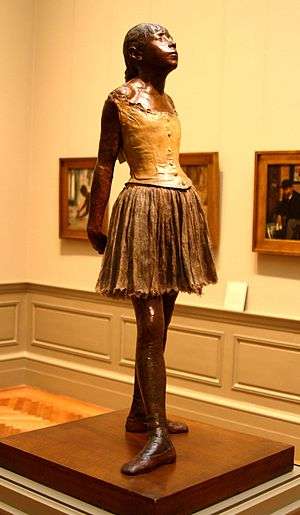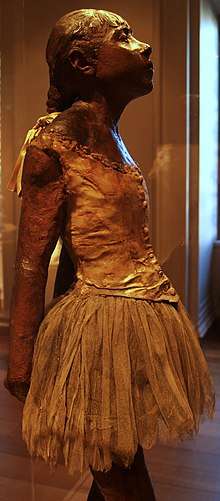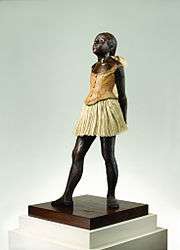Little Dancer of Fourteen Years
The Little Fourteen-Year-Old Dancer (French: La Petite Danseuse de Quatorze Ans) is a sculpture begun c. 1880 by Edgar Degas of a young student of the Paris Opera Ballet dance school, a Belgian named Marie van Goethem.
| Little Dancer of Fourteen Years | |
|---|---|
 | |
| Year | c.1880 |
| Dimensions | 98 cm (39 in) |
| Accession No. | 1985.64.62 |

Description
The sculpture is one-third life size and was originally sculpted in wax, a somewhat unusual choice of medium for the time. It is dressed in a real bodice, tutu and ballet slippers and has a wig of real hair. All but a hair ribbon and the tutu are covered in wax. The 28 bronze repetitions that appear in museums and galleries around the world today were cast after Degas' death. The tutus worn by the bronzes vary from museum to museum.
The exact relationship between Marie van Goethem and Edgar Degas is a matter of debate. It was common in 1880 for the "Petits Rats" of the Paris Opera to seek protectors from among the wealthy visitors at the back door of the opera.
Realistic wax figures with real hair and real clothes had also been popular in religious, Folk, and fine arts for centuries before Degas created his Little Dancer.[1][2]
The arms are taut, and the legs and feet are placed in a ballet position akin to fourth position at rest, and there is tension in the pose, an image of a ballerina being put through her paces, not posing in an angelic way. Her face is – "contorted, people thought it was a deliberate image of ugliness, but you could also say it's the image of a sickly gawky adolescent who is being made to do something she doesn't totally want to do."[3]
History

When the La Petite Danseuse de Quatorze Ans was shown in Paris at the Sixth Impressionist Exhibition of 1881, it received mixed reviews. Joris-Karl Huysmans called it "the first truly modern attempt at sculpture I know." Certain critics were shocked by the piece, and the dancer was compared to a monkey and an Aztec. One critic, Paul Mantz, called her the "flower of precocious depravity," with a face "marked by the hateful promise of every vice" and "bearing the signs of a profoundly heinous character."[4] Comparisons with older art were made, perhaps partly because it was exhibited in a glass case, like classical sculpture in the Louvre, and was dressed in wig and clothes.
After Degas' death, his heirs (brother and sister's children[5]) made the decision to have the bronze repetitions of La Petite Danseuse and other wax and mixed-media sculptures cast. The casting took place at the Hébrard foundry in Paris from 1920 until 1936 when the Hébrard foundry went bankrupt and closed.[6] Thereafter, "Hébrard" Degas Little Dancer bronzes were cast at the Valsuani foundry in Paris until the mid-1970s.[7] Sixty-nine of Degas' wax sculptures survived the casting process. One copy of La Petite Danseuse is currently owned by the creator and owner of Auto Trader, John Madejski. He stated that he bought the sculpture by accident. That copy was sold for £13,257,250 ($19,077,250) at Sotheby's on February, 3rd 2009.[8] Another Hébrard Little Dancer bronze failed to sell at a November 2011 auction at Christie's.[9]
To construct the statue, Degas used pigmented beeswax, with a metal armature, rope, and paintbrushes covered by clay for structural support.[10]
The Little Dancer wax sculpture we see today is a reworked version of the original sculpture that was shown in 1881. After seeing the wax sculpture in Degas’ living quarters in April 1903, the New York collector Louisine Havemeyer expressed interest in buying the wax. After proposing a bronze or cast wax of the sculpture, which Mrs. Havemeyer refused, Degas took his wax figure upstairs to his working studio and told Vollard he was reworking the sculpture for Havemeyer for 40,000 francs.[11] Degas never sold the sculpture to Mrs. Havemeyer. After Degas died, it was found in a corner of his studio. Paul Lefond, Degas’ biographer, described the Little Dancer wax after Degas’ death as "nothing but a ruin;"[12] and Mary Cassatt telegraphed Mrs. Havemeyer "Statue Bad Condition."[13] However, the wax sculpture we know today is not a ruin. It is Degas' reworked second version of his wax figure. At some point before Degas extensively reworked his sculpture, he allowed a plaster to be cast from the wax figure. This recently re-discovered plaster records the Little Dancer’s original pose, bodice, and hairdo. The plaster is now in a private collection in the United States.[14]
The original wax sculpture was acquired by Paul Mellon in 1956. Beginning in 1985, Mr and Mrs Mellon gave the National Gallery of Art 49 Degas waxes, 10 bronzes and 2 plasters, the largest group of original Degas sculptures. Little Dancer was among the bequests. In 1997, the Airaindor-Valsuani foundry in France began casting a limited edition of Degas bronzes from the pre-1903 Little Dancer plaster. One such Little Dancer bronze is owned by the M.T. Abraham Foundation, which, at times, is lent to other institutions and museums including the State Hermitage Museum in Saint Petersburg, Russia.[15] Like the various states of many of Degas' prints, the Valsuani bronzes record the first version of Degas' Little Dancer, while the Hébrard casts record the second and final state of the sculpture.
Cultural references
Art historian Richard Kendall published a scholarly account of the history of Degas's sculpture, Degas and the Little Dancer, with contributions by Douglas Druick and Arthur Beale.[16] A 2003 ballet with choreography by Patrice Bart and music by Denis Levaillant, La Petite Danseuse de Degas, was premiered by the Paris Opera. The 2004 BBC Two documentary The Private Life of a Masterpiece: Little Dancer Aged Fourteen closely examines the sculpture, the model, the circumstances of her life, and the critical reaction to the work. Cathy Marie Buchanan's 2013 novel, The Painted Girls, presents a fictionalised account of the life of Marie van Goethem, the model for the sculpture,[17] as does Carolyn Meyer's young adult novel Marie, Dancing[18] and Laurence Anholt's children's picture book Degas and the Little Dancer.[19]
In 2014, the Kennedy Center for the Performing Arts in Washington, D.C. premiered the stage musical, Little Dancer, inspired by the story of the young ballerina immortalized by Edgar Degas in his famous sculpture. In March of 2019 a reworked version of the musical, now called Marie, Dancing Still premiered at the 5th Avenue Theater in Seattle. On September 12, 2016, Dr. Gregory Hedberg presented a paper entitled "Unraveling the Mysteries of Degas’ Little Dancer, Aged Fourteen," at the French Institute, Alliance Français, in New York City.[20]
The sculpture is prominently featured in the 1993 thriller Malice.
References
- Joseph Czestochowski and Anne Pingeot; Reff, Theodore (2002). "To Make Sculpture Modern". Degas Sculptures. Memphis: Torch Press. pp. 52–3.
- Kendall, Richard (1998). Degas and the Little Dancer. Yale University Press. p. 32.
- Tim Marlow on... Degas, Sickert & Toulouse-Lautrec' Channel 5 TV
- "Degas's Little Dancer is still on the point of controversy". 2011-11-02.
- "National Gallery of Art". 2011-11-02.
- Joseph Czestochowski and Anne Pingeot; Pingeot, Anne (2002). "Degas and His Castings". Degas Sculptures. Memphis: Torch Press. p. 34.
- Hedberg, Gregory (2016). Degas’ Little Dancer, Aged Fourteen: The earlier version that helped spark the birth of modern art. Arnoldsche Fine Art Publishers. pp. 10, 19, 28 n. 6–7, 30 n. 44, 74, 99 n. 221, 272–281.
- "Auction results". 2009-02-04.
- "Degas Ballerina Fails to Sell at Christie's as Markets Plummet". 2011-11-02.
- Suzanne G. Lindsay, Daphne S. Barbour, and Shelley G. Sturman (2010). Edgar Degas Sculpture: The Collections of the National Gallery of Art, Systematic Catalogue. Washington, D.C.: National Gallery of Art. pp. 116–119.CS1 maint: multiple names: authors list (link)
- Ann Dumas, Colta Ives, Susan Alyson Stein, and Gary Tinterow; Tinterow, Gary (1997). "Appendix: Mary Cassatt on the Degas Sales and the Casting of Sculpture". The Private Collection of Edgar Degas. New York: The Metropolitan Museum of Art. p. 101.CS1 maint: multiple names: authors list (link)
- Lafond, Paul (1918–19). Degas, vol. II. Paris: H. Floury. p. 66.
- Jean Sutherland Boggs, Douglas W. Druick, Henri Loyrette, Michael Pantazzi, and Gary Tinterow; Pantazzi, Michael (1988). "The Little Fourteen-Year-Old Dancer". Degas. New York: The Metropolitan Museum of Art. pp. 352, n. 12.CS1 maint: multiple names: authors list (link)
- Hedberg, Gregory (2016). Degas’ Little Dancer, Aged Fourteen: The earlier version that helped spark the birth of modern art. Arnoldsche. pp. 10–64.
- Mikhail B. Piotrovsky; Amir Gross Kabiri; Geraldine Norman; Jon Whiteley; June Hargrove; Dalit Lahav-Durst (2013). Edgar Degas: Figures in Motion. St. Petersburg: Petronius Publishing House, Ltd. p. 65.
- Kendall, Richard (1998). Degas and the Little Dancer. Yale university Press. ISBN 0-300-07497-2.
- "The Painted Girls". 2009-02-04.
- "Marie, Dancing". 2009-02-04.
- "Degas and the Little Dancer".
- Hedberg, Gregory. ""Unraveling the Mysteries of Degas' Little Dancer, Aged Fourteen"". YouTube.
External links
| Wikimedia Commons has media related to La Petite Danseuse de Quatorze Ans. |
- Little Dancer Aged Fourteen sculpture at the National Gallery of Art.
- "Little Dancer Musical Imagines The Story Behind Degas' Mysterious Muse" NPR
- The Little Fourteen–Year–Old Dancer sculpture at the Metropolitan Museum of Art.
- Little Dancer Aged Fourteen in the Tate Collection, London
- Little Dancer aged fourteen in the Robert and Lisa Sainsbury Collection.
- The Little Dancer, Aged Fourteen at the Hay Hill Gallery in London.
- Degas's Little Dancer at the National Gallery of Art.
- The Little Dancer of Fourteen Years at the M.T. Abraham Foundation
- Degas: The Artist's Mind, exhibition catalog from The Metropolitan Museum of Art fully available online as PDF, which contains material on Little Dancer of Fourteen Years (see index)
- Little Dancer, The John F.Kennedy Center for the Performing Arts.
- "Unraveling the Mysteries of Degas’ Little Dancer, Aged Fourteen" YouTube
- Little Dancer Aged Fourteen (Degas) - 2 Minute Video | Check123 - Video Encyclopedia